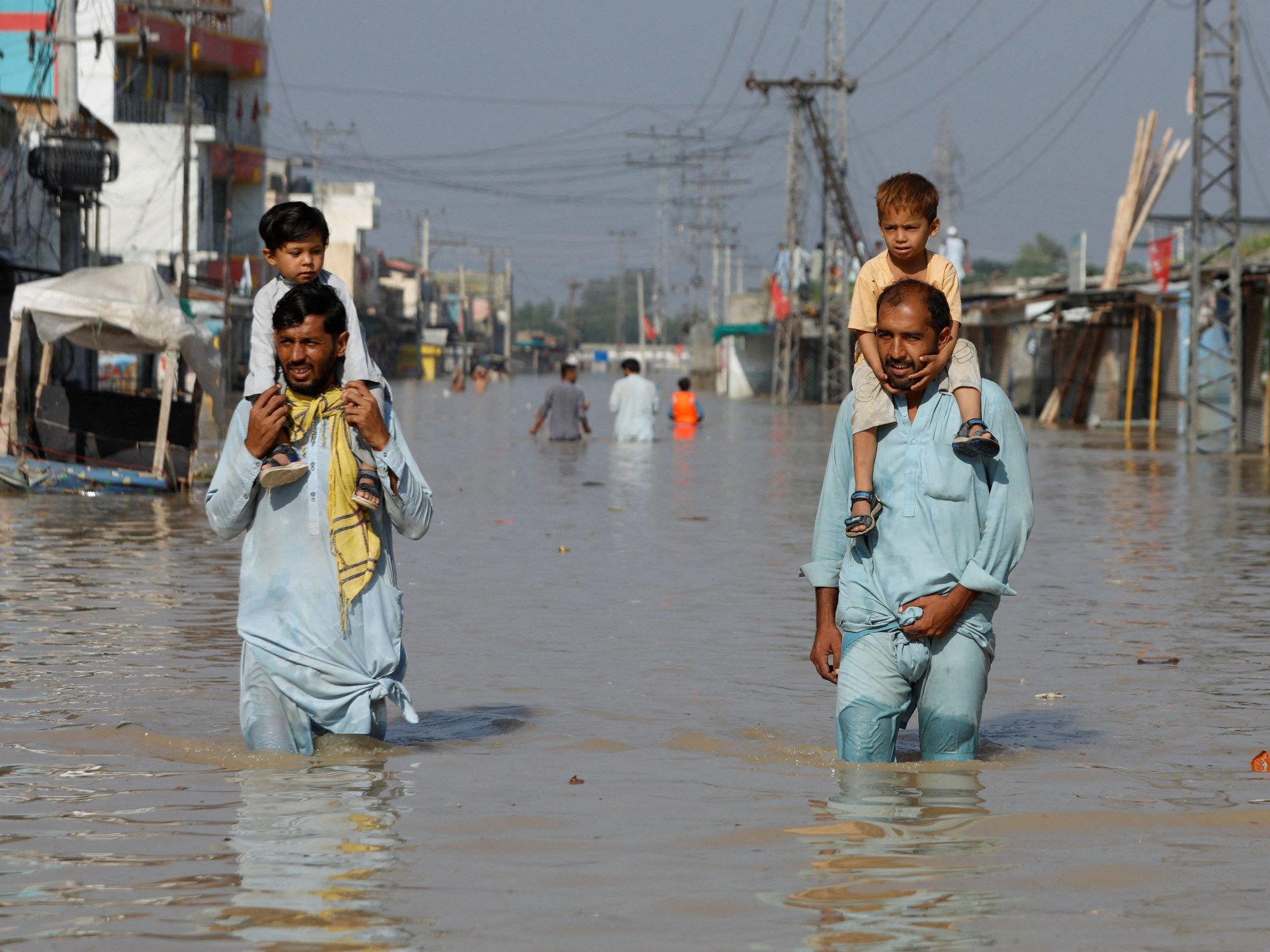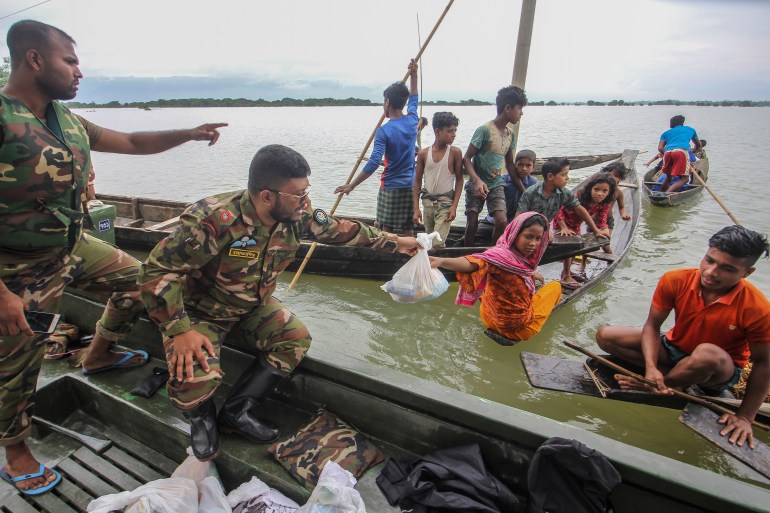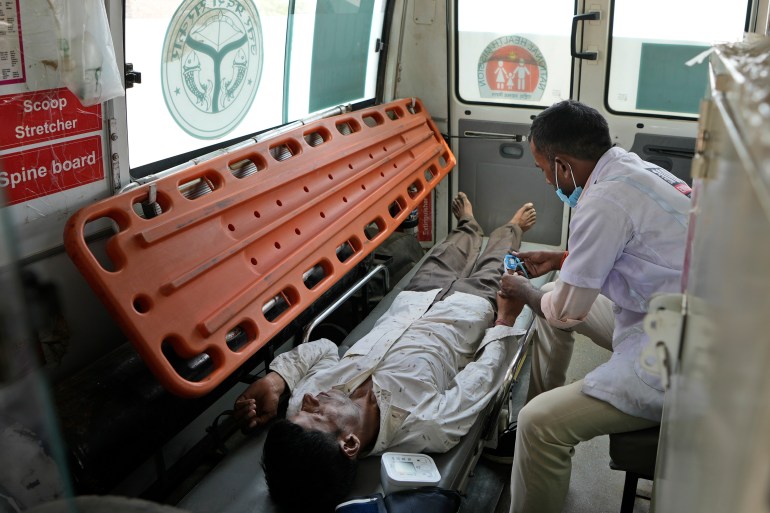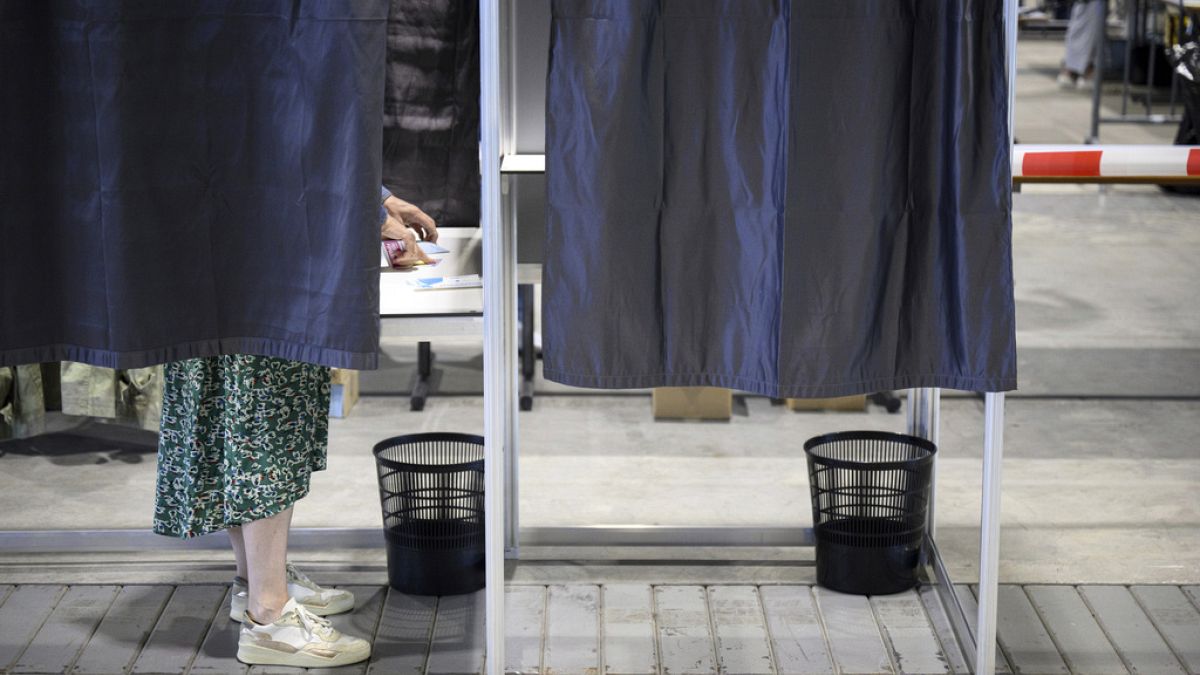World
What makes South Asia so vulnerable to climate change?

Heavy monsoon rains in Pakistan over the past week killed at least 50 people across the country, nearly a year after massive flooding killed more than 1,700 people and affected 33 million others.
In neighbouring India, about a dozen districts in the northeastern state of Assam were hit by deadly flash floods in June, forcing thousands to flee their homes and seek refuge at makeshift relief camps.
The ravaging floods – which killed at least 11 people – meant many faced the daunting task of rebuilding their lives as they returned to destroyed homes and drowned livestock.
Climate-change-induced downpours, drought, and soaring temperatures have become increasingly common across the eight countries of South Asia, making it one of the world’s most vulnerable regions to the impacts of global warming.
Saleemul Haq, director at the International Centre for Climate Change and Development, said the region is particularly at risk because of a combination of geography, population and poverty.
“Over a billion and a half people are living in an area that is not such a big part of the world. It has major river systems from the Hindu Kush and the Himalayan mountain regions flowing through,” he told Al Jazeera.
Some 750 million people in South Asia have been affected by at least one natural disaster, according to data compiled by the Washington-based World Bank.
The lack of land to grow food, water shortages, and displacement of populations are some of the challenges the region is facing as climate experts predict irreversible consequences to the livelihoods of hundreds of millions.
Food insecurity
For thousands of years, South Asia was seen as the world’s “granary” for agriculture – a region with weather patterns well-suited for growing crops, Pakistan-based climate scientist Fahad Saeed told Al Jazeera.
“However, with the onset of climate change, the delicate balance which was important for crops to grow has been disturbed,” Saeed said.
Results from a study published in 2021 on wheat production up to 2050, using crop simulation models, found the most negative effects will be seen in South Asian nations with a yield decline of 16 percent.
Environmentalist Anjal Prakash said climate change will have “significant implications” for food security in South Asia.
“Rising temperatures, changing precipitation patterns, and increased frequency of extreme weather events such as droughts, floods, and storms … pose substantial challenges to agricultural systems in the region,” said Prakash, adding livestock productivity and fisheries will be adversely affected.
Furthermore, Prakash said climate change could also make water availability of a significant issue in the region, which has one of the highest number of glaciers in the world, situated in the Himalayas.
“Melting glaciers and changes in rainfall patterns can disrupt irrigation systems, affecting crop growth and exacerbating water scarcity,” Prakash, who has previously worked with the UN’s Intergovernmental Panel on Climate Change, asserted.
A University of Leeds study published in 2021 found the ice from glaciers in the Himalayas is melting “at least 10 times higher than the average rate over past centuries”, a result of human-induced climate change.
Researchers said the Himalayas, which cover countries such as Pakistan, Nepal and India, had lost 40 percent of their ice over several hundred years.
Water scarcity and low crop yields will result in adding to the continuing hunger crisis in the region, climate experts said.
In 2021, the UN’s Food and Agriculture Organization (FOA) said some 21 percent of people in South Asia faced severe food insecurity, a 2 percent rise from 2020. In the same year, the region had the highest number of undernourished people in the world – 330 million – the FOA said.
‘Push factor’
Fears of declines in food production, together with other climate-related calamities such as rising sea levels, have also raised the alarm as millions in South Asia are being internally displaced.
A report published by activist group ActionAid in 2020 estimated the region could see up to 63 million people become migrants by 2050 as a result of extreme weather events.
Huq said displacement from human-induced climate change was further adding to economic migration from rural to urban areas – a continuing phenomenon worldwide – with South Asia being a major “hotspot”, with the greatest displacement taking place in low-lying coastal areas.
“Climate change … is exacerbating the ‘push factor’ – the motivation to migrate away from place of residence – for people who are living in places where they can no longer continue to have livelihoods that they used to have, whether it’s farming or fishing,” he said.
“From the damage that occurs to infrastructure, agricultural land and homes, many people that evacuate aren’t able to go home again. They become effectively refugees.”

In Bangladesh, Huq said an estimated 2,000 people were moving to the capital Dhaka, many displaced by the effects of extreme weather from lowland coastal districts such as Barisal and Satkhira.
“Dhaka is one of the fastest-growing megacities in the world. Absorbing many millions – possibly in the region of 10 million new climate migrants over the next decade – is just going to be impossible. Facilities are inadequate for the existing population. They’re going to be even more inadequate for the additional population,” said Huq.
Concerns for human health
Climate scientists also warned that extreme weather patterns are aggravating the dire health conditions in some of the world’s poorest regions, with South Asia being no exception.
Physician and climate analyst K Srinath Reddy of the Public Health Foundation of India said heavy rainfall and floods are a precursor for a myriad of vector-borne diseases.
“Malaria, chikungunya, dengue fever are already present as health challenges in South Asia, but they’re going to markedly increase because of several factors such as rising temperatures,” he told Al Jazeera.
“Mosquitoes can breed in warmer areas which have now opened up. In fact, as humans are wilting in the heat, mosquitoes become athletic and can rise to higher heights and so can spread farther and faster. You will find even hilly areas which were previously not malaria prone now much more malaria prone at higher altitudes.”

Meanwhile, the increased intensity of heatwaves in South Asia has been linked to illnesses, including cardiovascular and respiratory disease, Reddy said.
According to a study by the World Weather Attribution, deadly heatwaves in India and Bangladesh in mid-April were made 30 times more likely because of climate change.
A study published by Lancet in October showed India had seen a 55 percent rise in fatalities from extreme heat in the periods between 2000-2004 and 2017-2021.
Rais Akhtar, a climate expert and former professor at Jawaharlal Nehru University, said the dire state of health facilities in South Asia would make it easier for extreme weather to affect human health, especially in rural areas where most people live.
“In countries like Bangladesh and India, there is a dualism of sorts where in certain cities, there are well-established healthcare facilities. But in the rural, underdeveloped areas, these facilities are severely lacking … including shortage of doctors,” he told Al Jazeera.
People must travel to major cities to receive treatment, a costly ordeal for many.
Saeed, associated with German think tank Climate Analytics, noted in addition to weak health infrastructure in South Asia, governments do not possess the response and rescue capacity to provide adequate relief when climate-related calamities strike.
“The devastation from last year’s floods were so huge … affecting around 33 million people … that government authorities such the National Disaster Management Authority and hospitals were caught on their heels,” he said.
Moreover, the catastrophic floods also directly affected numerous health facilities across Pakistan, with the World Health Organization reporting more than 1,400 hospitals were destroyed or damaged, leaving thousands without access to medical care.

World
Israel moves towards ceasefire deal with Hezbollah: reports

Israel is reportedly moving towards a ceasefire agreement with Hezbollah in Lebanon after nearly a year of fighting escalated into an all-out war in September.
Israeli media outlets including YNET and Haaretz have reported that Israel has tentatively agreed to a U.S.-backed proposal for a ceasefire. No final deal has been reached, according to the reports.
Journalists take pictures of a building hit direct by a rocket fired from Lebanon in Haifa, Israel, Sunday Nov. 24, 2024. (AP Photo/Francisco Seco)
Lebanon and the militia group Hezbollah reportedly agreed to the deal last week but both sides need to give the final okay before it can materialize.
The reported ceasefire deal comes after Hezbollah launched one of its largest rocket attacks on Israel in exchange for Israeli forces striking Hezbollah command centers in Beirut.
This is a developing story. Check back for updates.
World
Yamandu Orsi wins Uruguay’s run-off presidential election

Yamandu Orsi, the candidate for the left-wing Broad Front coalition, is projected to emerge victorious in Uruguay’s run-off election for the presidency.
He bested Alvaro Delgado of the ruling National Party to win the tightly fought race, though public opinion polls showed the two candidates in a dead heat in the lead-up to Sunday’s vote.
Orsi’s supporters took to the streets in the capital of Montevideo, as the official results started to show the former mayor and history teacher surging ahead.
Many waved the party banner: a red, blue and white striped flag with the initials FA for “Frente Amplio”, which translates to “Broad Front”.
“Joy will return for the majority,” the coalition posted on social media as Orsi approached victory. “Cheers, people of Uruguay.”
Orsi’s win restores the Broad Front to power in the small South American country, sandwiched on the Atlantic coast between Brazil and Argentina.
For 15 years, from 2005 to 2020, the Broad Front had held Uruguay’s executive office, with the presidencies of Jose Mujica and Tabare Vazquez, the latter of whom won two non-consecutive, five-year terms.
But that winning streak came to an end in the 2019 election, with the victory of current President Luis Lacalle Pou, who led a coalition of right-leaning parties.
Under Uruguay law, however, a president cannot run for consecutive terms. Lacalle Pou was therefore not a candidate in the 2024 race.
Running in his stead was Delgado, a former veterinarian and Congress member who served as a political appointee in Lacalle Pou’s government from 2020 to 2023.
Even before the official results were announced on Sunday, Delgado had conceded, acknowledging Orsi’s victory was imminent.
“Today, the Uruguayans have defined who will hold the presidency of the republic. And I want to send here, with all these actors of the coalition, a big hug and a greeting to Yamandu Orsi,” Delgado said in a speech as he clutched a large Uruguayan flag in his hand.
He called on his supporters to “respect the sovereign decisions” of the electorate, while striking a note of defiance.
“It’s one thing to lose an election, and another to be defeated. We are not defeated,” he said, pledging that his right-wing coalition was “here to stay”.
The outgoing president, Lacalle Pou, also reached out to Orsi to acknowledge the Broad Front’s victory.
“I called [Yamandu Orsi] to congratulate him as president-elect of our country and to put myself at his service and begin the transition as soon as I deem it pertinent,” Lacalle Pou wrote on social media.

Orsi had been considered the frontrunner in the lead-up to the first round of the elections.
Originally from Canelones, a coastal regional in the south of Uruguay, Orsi began his career locally as a history teacher, activist and secretary-general of the department’s government. In 2015, he successfully ran to be mayor of Canelones and won re-election in 2020.
In the 2024 presidential race, Orsi – like virtually all the candidates on the campaign trail – pledged to bolster Uruguay’s economy. He called for salary increases, particularly for low-wage workers, to grow their “purchasing power”.
He also called for greater early childhood education and employment programmes for young adults. According to a United Nations report earlier this year, nearly 25 percent of Uruguay’s children live in poverty.
But the economy was not the only issue at the forefront of voters’ minds. In a June survey from the communications firm Nomade, the largest share of respondents – 29 percent – identified “insecurity” as Uruguay’s “principal problem”.
That dwarfed the second-highest ranked topic: “Unemployment” was only picked by 15 percent of respondents.
As part of his platform, Orsi pledged to increase the police force and strengthen Uruguay’s borders, including through the installation of more security cameras.
As he campaigned, Orsi enjoyed the support of former President Mujica, a former rebel fighter who survived torture under Uruguay’s military dictatorship in the 1970s and ’80s.
Mujica remains a popular figure on Uruguay’s left, best known for his humble living arrangements that once earned him the moniker of the “world’s poorest president”.

In the first round of voting, on October 27, Orsi came out on top, with 44 percent of the vote to Delgado’s 27 percent. But his total was far short of the 50 percent he needed to win the election outright, thereby triggering a run-off.
The race got tighter from there forward. Only two candidates progressed to the run-off – Delgado and Orsi – and Delgado picked up support from voters who had backed former Colorado Party candidate Andres Ojeda, a fellow conservative who was knocked out in the first round.
Nevertheless, Orsi quickly pulled ahead after the polls closed for the run-off election on Sunday.
“The horizon is brightening,” Orsi said in his victory speech. “The country of freedom, equality and also fraternity triumphs once again.”
World
Cinematography Work at Camerimage Festival ‘Radically Different,’ Jury Members Say

Jurors at the EnergaCamerimage cinematography fest say the Golden Frog main competition films have been remarkably varied and inspiring in the event’s 32nd edition.
The 12 competing films “were radically different from each other,” said “Barbie” and “Killers of the Flower Moon” cinematographer Rodrigo Prieto, whose directorial debut, “Pedro Paramo,” is also screening at the fest. “I enjoyed that.”
The varied styles, approaches and storytellers, he added, defied easy categorization. “Happily, I didn’t notice trends, which I have noticed sometimes in the past in some festivals.”
Juror Anthony Dod Mantle, who won Golden Frogs in 2008 for his lensing of “Slumdog Millionaire” and in 2016 for “Snowden,” said, “I’ve been to this festival before and the overall collection of films and categories, I felt, was even wider. I feel slight absence of certain films from other ethnic backgrounds. They were different, these films, but they could be far more different.”
Greater diversity and inclusion in cinematography has justly been a hot topic this year at Camerimage, he added. “It’s good we embrace that, celebrate it here, because not many festivals do that.”
Dod Mantle described the current state of cinematography, based on what the jury’s seen this week, as “openly variable and that’s why we praise some films rather than others because they challenge convention.”
He also described the industry as “in a bit of a pickle,” adding, “We know that. We have to applaud ourselves and embrace and encourage every single essence of, molecule of, exploration and challenging cinema.”
Juror Lukasz Zal, who filmed “The Zone of Interest” and “Cold War,” said “I feel really inspired. I feel this kind of positive envy when you just see something which you admire, and love – cinema is still in good condition.”
And, he added, “I’m becoming hopeful that, OK, there’s still a lot to discover. For this, I really love Camerimage. When I was here, when I was a student, I was always coming back home after festival, with this feeling, kind of eager to work, to prepare and to just be really open and be full of ideas.”
Spending time here again as a top professional in his field, Zal said, “I feel again like a student.”
Juror Cate Blanchett said it’s clear cinematography has no crisis of creativity currently.
Instead, there’s a different issue: “The pickle is how one gets access and is able to see these films in the way that they’re intended to be seen.”
Technology advances in the field are also helping storytelling onscreen evolve, she added, rather than distracting from it. “Sometimes you can see there’s been huge technical advances made, or there’s been big innovations, and they haven’t yet been integrated into the stories that they’re being applied to. Whereas I thought there were so many films here that have really integrated the technology and in a completely adventurous and inventive way that was not pretentious. It was very interwoven and enmeshed with the performances and the stories.”
Jury duty at Camerimage is rewarding, said Dod Mantle, because the Golden Frog award can often help promising cinematographers break through to booming careers.
He described the potential effect of the award as “enormous.”
“The first time I came here, in competition,” he recalled, “it illustrated for me the jury was embracing cinema, celebrating something different and challenging.”
Cinematographers are keenly aware of the judgment of their peers, Dod Mantle added. “You feel quite vulnerable here. I’ve seen cinematographers leave the festival and go spend the weekend in Krakow and come back. The frog, ultimately is a beautiful thing celebrating our colleagues’ work.”
Juror Anna Higgs, a producer and columnist who works closely with BAFTA, said, “I think we should normalize cinematographers getting asked for their autographs – the fact that this frog is the idolized thing here.”
Blanchett added, “It’s very rare that you go to a festival where every single person in the auditorium sits right through the credit roll to the very end.” She noted “the respect that is shown to every single crewmember.”
Prieto recalled the impact of his own Golden Frog cinematography win in 2000 for “Amores Perros” fondly. “I do cherish that frog. It’s wonderful to get a frog, but more than anything, it’s a place where cinematography is the focus and is celebrated, and to share that obsession with so many people, and the energy of that, is really wonderful.”
Zal had a similar career boost, he said, after winning for lensing “Ida” by Pawel Pawlikowski in 2013. “That’s really the moment when somehow my career changed. I was always dreaming while having student films here. And it was beautiful to get an award from colleagues and being here and being among amazing cinematographers.
“I was put in competition with the people who I admire. Even now, sitting with Rodrigo, who for me was a huge inspiration. I was shooting my films in school inspired by ‘Amores Perros.’ Now we’re sitting together on the jury. That’s amazing, that’s beautiful.”
Blanchett described the close proximity of students and top international lensers as a unique strength of Camerimage, praising “the mentorship that goes on, how you’ll champion the works of other people.”
“I think that’s why it’s so vitally important that there’s an increased level of female participation. Because of the networking and mentorship opportunities and championing the work. The conversations and the opportunities that arise from those conversations are really important.”
Oscar-winning costume designer Sandy Powell (“Shakespeare in Love,” “The Aviator” and “The Young Victoria”) and cinematographer and documentary filmmaker Jolanta Dylewska also served on the Camerimage jury, calling earlier this week for greater diversity and inclusion in the industry.
-

 Business1 week ago
Business1 week agoColumn: Molly White's message for journalists going freelance — be ready for the pitfalls
-

 Science5 days ago
Science5 days agoTrump nominates Dr. Oz to head Medicare and Medicaid and help take on 'illness industrial complex'
-

 Politics1 week ago
Politics1 week agoTrump taps FCC member Brendan Carr to lead agency: 'Warrior for Free Speech'
-
/cdn.vox-cdn.com/uploads/chorus_asset/file/25739950/247386_Elon_Musk_Open_AI_CVirginia.jpg)
/cdn.vox-cdn.com/uploads/chorus_asset/file/25739950/247386_Elon_Musk_Open_AI_CVirginia.jpg) Technology6 days ago
Technology6 days agoInside Elon Musk’s messy breakup with OpenAI
-

 Lifestyle1 week ago
Lifestyle1 week agoSome in the U.S. farm industry are alarmed by Trump's embrace of RFK Jr. and tariffs
-

 World1 week ago
World1 week agoProtesters in Slovakia rally against Robert Fico’s populist government
-

 News7 days ago
News7 days agoThey disagree about a lot, but these singers figure out how to stay in harmony
-

 News1 week ago
News1 week agoGaetz-gate: Navigating the President-elect's most baffling Cabinet pick








/cdn.vox-cdn.com/uploads/chorus_asset/file/25753264/Screenshot_2024_11_24_at_4.53.29_PM.png)








